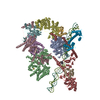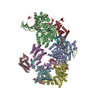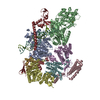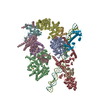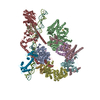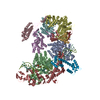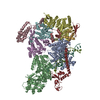+Search query
-Structure paper
| Title | Lesion recognition by XPC, TFIIH and XPA in DNA excision repair. |
|---|---|
| Journal, issue, pages | Nature, Vol. 617, Issue 7959, Page 170-175, Year 2023 |
| Publish date | Apr 19, 2023 |
 Authors Authors | Jinseok Kim / Chia-Lung Li / Xuemin Chen / Yanxiang Cui / Filip M Golebiowski / Huaibin Wang / Fumio Hanaoka / Kaoru Sugasawa / Wei Yang /     |
| PubMed Abstract | Nucleotide excision repair removes DNA lesions caused by ultraviolet light, cisplatin-like compounds and bulky adducts. After initial recognition by XPC in global genome repair or a stalled RNA ...Nucleotide excision repair removes DNA lesions caused by ultraviolet light, cisplatin-like compounds and bulky adducts. After initial recognition by XPC in global genome repair or a stalled RNA polymerase in transcription-coupled repair, damaged DNA is transferred to the seven-subunit TFIIH core complex (Core7) for verification and dual incisions by the XPF and XPG nucleases. Structures capturing lesion recognition by the yeast XPC homologue Rad4 and TFIIH in transcription initiation or DNA repair have been separately reported. How two different lesion recognition pathways converge and how the XPB and XPD helicases of Core7 move the DNA lesion for verification are unclear. Here we report on structures revealing DNA lesion recognition by human XPC and DNA lesion hand-off from XPC to Core7 and XPA. XPA, which binds between XPB and XPD, kinks the DNA duplex and shifts XPC and the DNA lesion by nearly a helical turn relative to Core7. The DNA lesion is thus positioned outside of Core7, as would occur with RNA polymerase. XPB and XPD, which track the lesion-containing strand but translocate DNA in opposite directions, push and pull the lesion-containing strand into XPD for verification. |
 External links External links |  Nature / Nature /  PubMed:37076618 / PubMed:37076618 /  PubMed Central PubMed Central |
| Methods | EM (single particle) |
| Resolution | 3.3 - 7.1 Å |
| Structure data | EMDB-27996, PDB-8ebs: EMDB-27997, PDB-8ebt: EMDB-27998, PDB-8ebu: EMDB-27999, PDB-8ebv: EMDB-28000, PDB-8ebw: EMDB-28001, PDB-8ebx: EMDB-28002, PDB-8eby:  EMDB-29673: Bulky DNA lesion recognition complex 3  EMDB-29674: Initial DNA-lesion (Cy5) binding by XPC and TFIIH focused |
| Chemicals |  ChemComp-SF4:  ChemComp-ZN:  ChemComp-CA: |
| Source |
|
 Keywords Keywords | DNA BINDING PROTEIN/DNA /  Protein-DNA complex / DNA BINDING PROTEIN-DNA complex Protein-DNA complex / DNA BINDING PROTEIN-DNA complex |
 Movie
Movie Controller
Controller Structure viewers
Structure viewers About Yorodumi Papers
About Yorodumi Papers




